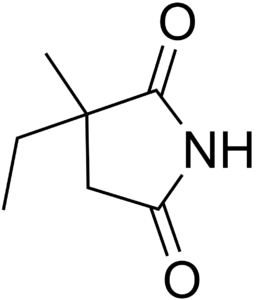Etosuximida
 | |
| Malaltia objecte | absència epilèptica de l'infant i epilèpsia |
|---|---|
| Dades clíniques | |
| Risc per l'embaràs | categoria D per a l'embaràs a Austràlia i categoria C per a l'embaràs als EUA |
| Grup farmacològic | compost químic |
| Codi ATC | N03AD01 |
| Dades químiques i físiques | |
| Fórmula | C7H11NO2 |
| Massa molecular | 141,078979 Da |
| Identificadors | |
| Número CAS | 77-67-8 |
| PubChem (SID) | 3291 |
| IUPHAR/BPS | 7182 |
| DrugBank | DB00593 |
| ChemSpider | 3175 |
| UNII | 5SEH9X1D1D |
| KEGG | C07505 i D00539 |
| ChEBI | 4887 |
| ChEMBL | CHEMBL696 |
| AEPQ | 100.000.954 |
L'etosuximida és un fàrmac per tractar la crisi d'absència.[1] Pot ser usada amb altres anticonvulsius com l'àcid valproic.[1] Etosuximida és presa via oral.[1]
Els efectes secundaris resulten mínims.[2] Els efectes secundaris comuns inclouen pèrdua de gana, dolor abdominal, diarrea i sensació de cansament.[1] Els efectes secundaris greus inclouen pensaments suïcides, nivells baixos de glòbuls i lupus eritematós.[1][2]
L'etosuximida és de la família de la succinimida. La manera exacta d'actuació no està clara.[1]
L'etosuximida va ser aprovada per a ús mèdic als Estats Units el 1960.[1]
Referències
[modifica]- ↑ 1,0 1,1 1,2 1,3 1,4 1,5 1,6 «Ethosuximide». The American Society of Health-System Pharmacists. Arxivat de l'original el 21 desembre 2016. [Consulta: 8 desembre 2016].
- ↑ 2,0 2,1 [13 desembre 2016] WHO Model Formulary 2008. World Health Organization, 2009, p. 69, 74–75. ISBN 9789241547659 [Consulta: 8 desembre 2016].
Notes
[modifica]- ^ Patsalos, P. N. «Properties of Antiepileptic Drugs in the Treatment of Idiopathic Generalized Epilepsies». Epilepsia, 46, s9, 11-2005, pàg. 140–144. DOI: 10.1111/j.1528-1167.2005.00326.x. PMID: 16302888.
- ^ Pharmaceutical Associates, Incorporated. «Ethosuximide Approval Label» (PDF). Label and Approval History. Food and Drug Administration Center for Drug Evaluation and Research, 2000. [Consulta: 5 febrer 2006].
- ^ Katzung, B.. Basic and Clinical Pharmacology. 9th. Lange Medical Books/McGraw-Hill, 2003. ISBN 0071410929. «Drugs used in generalized seizures»
- ^ Andrulonis, P. A.; J. Donnelly; B. C. Glueck; C. F. Stroebel; B. L. Szabek «Preliminary data on ethosuximide and the Episodic dyscontrol syndrome». American Journal of Psychiatry, 137, 11, 11-1980, pàg. 1455–6. DOI: 10.1176/ajp.137.11.1455. PMID: 7435689.
- ^ «Specific petit mal anticonvulsants reduce calcium currents in thalamic neurons». Neurosci Lett, 98, 1, 13-03-1989, pàg. 74–8. DOI: 10.1016/0304-3940(89)90376-5. PMID: 2710401.
- ^ «Characterization of ethosuximide reduction of low-threshold calcium current in thalamic neurons». Annals of Neurology, 25, 6, 6-1989, pàg. 582–93. DOI: 10.1002/ana.410250610. PMID: 2545161.
- ^ «Differential effects of petit mal anticonvulsants and convulsants on thalamic neurones: calcium current reduction». British Journal of Pharmacology, 100, 4, 8-1990, pàg. 800–6. DOI: 10.1111/j.1476-5381.1990.tb14095.x. PMC: 1917607. PMID: 2169941.
- ^ «Different action of ethosuximide on low- and high-threshold calcium currents in rat sensory neurons». Neuroscience, 51, 4, 12-1992, pàg. 755–8. DOI: 10.1016/0306-4522(92)90515-4. PMID: 1336826.
- ^ «Kinetic and pharmacological properties of low voltage-activated Ca2+ current in rat clonal (GH3) pituitary cells». Journal of Neurophysiology, 68, 1, 7-1992, pàg. 213–32. PMID: 1325546.
- ^ Sayer RJ, Brown AM, Schwindt PC, Crill WE. "Calcium currents in acutely isolated human neocortical neurons." Journal of Neurophysiology. 1993 May;69(5):1596-606. PMID: 8389832 Fulltext
- ^ «Pharmacological properties of T-type Ca2+ current in adult rat sensory neurons: effects of anticonvulsant and anesthetic agents». Journal of Neurophysiology, 79, 1, 01-01-1998, pàg. 240–52. PMID: 9425195.
- ^ «On the action of the anti-absence drug ethosuximide in the rat and cat thalamus». Journal of Neuroscience, 18, 13, 01-07-1998, pàg. 4842–53. PMID: 9634550.
- ^ «Block of cloned human T-type calcium channels by succinimide antiepileptic drugs». Molecular Pharmacology, 60, 5, 2001, pàg. 1121–32. PMID: 11641441.
- ^ Bourgeois, BF «Combination of valproate and ethosuximide: antiepileptic and neurotoxic interaction». The Journal of Pharmacology and Experimental Therapeutics, 247, 3, 12-1988, pàg. 1128–32. PMID: 3144596.
Enllaços externs
[modifica]- Ethosuximide Arxivat 2006-04-27 a Wayback Machine. Internet Mental Health.
- MedlinePlus Drug Information: Ethosuximide Oral
- Zarontin Pfizer.
- Zarontin Arxivat 2011-01-10 a Wayback Machine. Drug information, published studies and current trials